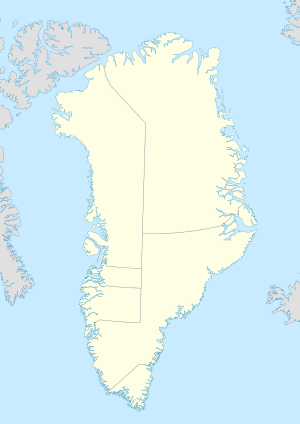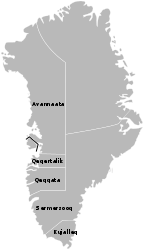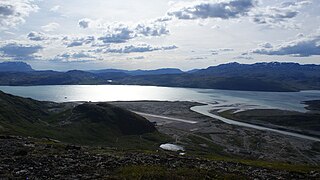
Narsarsuaq is a settlement in the Kujalleq municipality in southern Greenland. It had 123 inhabitants in 2020. There is a thriving tourism industry in and around Narsarsuaq, whose attractions include a great diversity of wildlife, gemstones, tours to glaciers, and an airfield museum.

Brattahlíð, often anglicised as Brattahlid, was Erik the Red's estate in the Eastern Settlement Viking colony he established in south-western Greenland toward the end of the 10th century. The present settlement of Qassiarsuk, approximately 5 km (3.1 mi) southwest from the Narsarsuaq settlement, is now located in its place. The site is located about 96 km (60 mi) from the ocean, at the head of the Tunulliarfik Fjord, and hence sheltered from ocean storms. Erik and his descendants lived there until about the mid-15th century. The name Brattahlíð means "the steep slope". The estate, along with other archeological sites in southwestern Greenland, was inscribed on the UNESCO World Heritage List in 2017 as Kujataa Greenland: Norse and Inuit Farming at the Edge of the Ice Cap.

Narsaq is a town in the Kujalleq municipality in southern Greenland. The name Narsaq is Kalaallisut for "Plain", referring to the shore of Tunulliarfik Fjord where the town is located.

Qaqortoq, formerly Julianehåb, is a city in, and the capital of, the Kujalleq municipality in southern Greenland, located near Cape Thorvaldsen. With a population of 3,050 in 2020, it is the most populous town in southern Greenland and the fourth or fifth-largest town on the island.

Alluitsup Paa is a village in the Kujalleq municipality in southern Greenland. Alluitsup Paa had 202 residents in 2020. Presently, the community's religious activities take place in Qaqortoq.

Aappilattoq is a village in the Kujalleq municipality in southern Greenland. The name means "red", after the red mountain rising above the settlement in the Greenlandic language. The settlement had 100 inhabitants in 2020.
Eqalugaarsuit is a settlement in the Kujalleq municipality in southern Greenland, located southeast of Qaqortoq and northwest of Alluitsup Paa. It had a population of 49 in 2020.
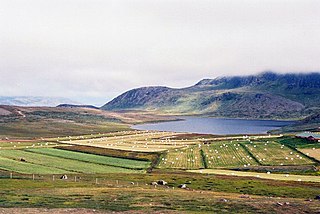
Igaliku is a settlement in the Kujalleq municipality in southern Greenland. The town was founded as Igaliko in 1783 by the trader and colonial administrator Anders Olsen and Greenlandic wife Tuperna. In 2020, Igaliku had 21 inhabitants. The nearby Norse ruins of Garðar and the farms surrounding the town were inscribed on the UNESCO World Heritage List in 2017 as part of the Kujataa Greenland: Norse and Inuit Farming at the Edge of the Ice Cap site.

Tasiusaq is a settlement in the Kujalleq municipality in southern Greenland, founded in 1933. It is located at the Tasermiut Fjord, east of Nanortalik. Its population was 53 in 2020. In the Greenlandic language, the name of the settlement means "like a lake", referring to the lake-looking bay it's situated on. The inhabitants call it "Tasiisaq", which is the local dialect.
Narsarmijit, formerly Narsaq Kujalleq and Frederiksdal, is a settlement in southern Greenland. It is located in the Kujalleq municipality near Cape Thorvaldsen. Its population was 66 in 2020. There has been a slow but steady pattern of emigration since the late 1950s.

Ammassivik is a settlement in the Kujalleq municipality in southern Greenland. The modern name is the Kalaallisut for "where you catch ammassaat (capelin)". Its population was 74 in 2010 and 32 in 2020.

Saarloq is a settlement in the Kujalleq municipality in southern Greenland. Its population was 21 in 2020. It is located on a small island with the same name off the Labrador Sea coast, at the mouth of the Qaqortoq Fjord, west of Alluitsup Paa and 20 km south of Qaqortoq.

Qassimiut is a settlement in the Kujalleq municipality in southern Greenland. The settlement was founded in 1835 as a trading station. With a population of 20 in 2020, it is the smallest organized, permanent settlement in Greenland.

Narsarsuaq Airport is an airport located in Narsarsuaq, a settlement in the Kujalleq municipality in southern Greenland. Along with Kangerlussuaq Airport, it is one of two airports in Greenland capable of serving large airliners. It is also the only international airport in southern Greenland. The settlement it serves is small, with the airport primarily functioning as a transfer point for passengers heading for the helicopter hubs of Air Greenland in Qaqortoq and Nanortalik. The airport is due to be closed in late 2026 when Qaqortoq Airport is scheduled to open.
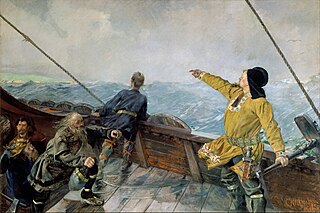
The Eastern Settlement was the first and by far the larger of the two main areas of Norse Greenland, settled c. AD 985 – c. AD 1000 by Norsemen from Iceland. At its peak, it contained approximately 4,000 inhabitants. The last written record from the Eastern Settlement is of a wedding in Hvalsey in 1408, placing it about 50–100 years later than the end of the more northerly Western Settlement.

Kujalleq is a municipality on the southern tip of Greenland, operational from 1 January 2009. The administrative center of the municipality is in Qaqortoq.

Tunulliarfik Fjord is a fjord near Qaqortoq in the Kujalleq municipality in southern Greenland. It is the inner section of Skovfjord (Skovfjorden). In times of the Norse settlement in southern Greenland, it was known as Eiriksfjord.
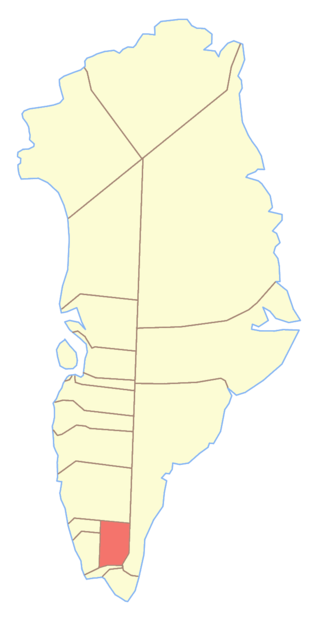
Narsaq Municipality was a municipality in south Greenland until 31 December 2008. The municipality consisted of Narsaq, and the settlements Qassiarsuk, Igaliku, and Narsarsuaq. Its administrative center was the town of Narsaq. It was incorporated into the new Kujalleq municipality on 1 January 2009, when the municipalities of Narsaq, Nanortalik, and Qaqortoq ceased to exist as administrative entities.

